The Investigator, formerly the Xenophon, was a sloop of war, and was fitted out in a most elaborate fashion for the cruise, carrying with her an artist (Westall), a botanist (Brown), an astronomer (Crossley), and several other scientists.
Among her officers were Samuel Flinders, second lieutenant and brother of Matthew, and a midshipman named John Franklin, afterwards Sir John Franklin, the Arctic explorer and at one time governor of Tasmania. Her total complement numbered 83 hands. The Lady Nelson, a colonial government brig, was ordered, on the arrival of the Investigator at Port Jackson, to join the expedition and act as tender to the larger vessel, and her history is scarcely less remarkable than that of the little vessel Norfolk, Flinders’ old command, which by this time had been run away with by convicts, and “piled up” on a beach near Newcastle, New South Wales.
The Investigator sailed, and Flinders made Cape Leeuwin on September 7th, 1801. He ran along the south and east coasts, met the Baudin expedition in Encounter Bay, and entered Port Phillip on April 26th, 1802, and found that the Lady Nelson had preceded him in the February before. Arriving in Sydney in May, he sailed again a couple of months later to the northward, surveying the Great Barrier Reef, Torres Straits, the Gulf of Carpentaria, and the coast of Arnhem’s Land. By this time the ship was too unseaworthy to prosecute further work, so Flinders sailed round the entire continent by way of the Leeuwin, and finally arrived in Sydney harbour again in June, 1803.
In these voyages he performed exploring work that is now a part of English history, and his charts of the Australian coasts were the foundation of all others that have since been made. He either first used the name of Australia or adapted it to the great continent, and New Holland, after the publication of his charts, began to be a name of the past.
Most of the remainder of this story can best be told in the words of Flinders and from the narratives of his officers.
The long and rough voyage of the Investigator had shaken her poor old carcase terribly, as the following summary of [Sidenote: 1805] an examination by the captains of the men-of-war then in Sydney Harbour and others will show:—
“On the port side out of ninety-eight timbers, eleven were sound, and sixty-three were uncertain if strained a little; on the starboard five out of eighty-nine timbers were good, fifty-six were uncertain, and twenty-eight rotten; the planking about the bows and amidships was so soft that a stick could be poked through it.”
Considering all these defects it was not worth while to keep her, so she was converted into a hulk in Sydney Harbour. But later on it was found that by cutting her down it might be possible to navigate her to England. This was done, and the old ship sailed from Sydney on May 24th, 1805, under the command of Captain Kent, who managed with the greatest difficulty to reach Liverpool on the 14th of October following. In his despatch announcing her arrival he says:—




